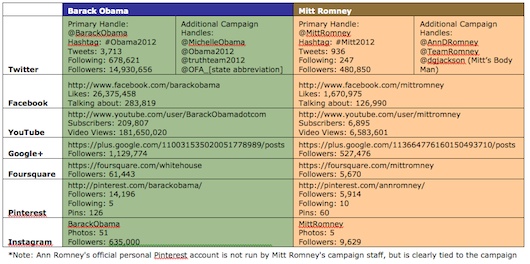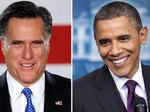How the Presidential Race is Engaging the Masses
This guest article is written by Janna Dons, Social Community Manager at Socialogic.
During the 2008 U.S. presidential race, social media entered the political landscape like never before. Each candidate tapped into the online chatter to reach tech-savvy voters. Barack Obama's campaign showed deft skill on sites like Facebook and Twitter, wrangling virtual followers and friends across the nation and engaging the youth vote in new ways. In his 2008 bid for candidacy, Mitt Romney became the first potential Republican nominee with a Facebook page.
Four years later, we've seen a significant up-tic in the political utilization of new social networks. The 2012 election campaigns are broadening their social media reach with almost every available platform. While both Obama and Romney have left their MySpace accounts dormant for some time (like many, if not most of today's social networkers), the two campaigns have been logging in and interacting with a slew of other outlets. Let's take a look at how Barack Obama and Mitt Romney are engaging right now:

Obama Campaign
Obama uses social media to recruit and unite the masses. The President's campaign organizers have created social media accounts for Obama for America in all 50 states. They've also created social media accounts for different societal demographics (recently adding Latinos for Obama) on Twitter, Facebook and even Instagram. The campaign is using the free outlets to disseminate targeted messages to relevant voter groups.
Accounts on individual social networks serve specific purposes. On Pinterest, which has a user base that skews predominantly female, the campaign has created boards for every aspect of the campaign, from event photos to the Obama 2012 Store. There's even an Obama-inspired recipes board, which is congruent with the kind of content that is traditionally shared over Pinterest.
Meanwhile, accounts specifically created for Barack and Michelle Obama post quotes and statements on current events. Though the Obama 2012 staff manages the Twitter accounts, some tweets are signed "-bo" or "-mo" to denote that they're coming directly from the President or First Lady.
The Obama 2012 campaign has also created a watchdog-type campaign subgroup, Truth Team 2012. It serves as a blog pushing facts and figures about both sides of the campaign through three sub categories: AttackWatch, KeepingHisWord, and KeepingGOPHonest. These focus respectively on debunking statements that attack Obama; promoting positive coverage of Obama; and posting blog entries or ads that criticize Mitt Romney's campaign, history and positions. Truth Team 2012 serves as a blog-style outlet in conjunction with the campaign blog, and is primarily publicized through its Twitter account and Pinterest board, which the other campaign accounts retweet and use as a source for additional posts and comments.
Having been credited with pioneering the incorporation of social media into the office of the President (even hosting a town hall on Facebook in 2011), it seems only natural that the Obama team would create its own social network for the campaign. My.BarackObama.com is a hub for supporters to create their own profiles and contribute content. Creating a new social sphere allows supporters to identify with one another in a familiar environment and feel more engaged in the campaign.
Romney Campaign
In the past, Romney has faced criticism from tech-savvy voters for appearing out of touch and stiff. Social media is an opportunity to re-introduce him to the public and showcase Romney's positive characteristics, simultaneously creating a steady dialogue about his political convictions. Romney doesn't have the same advantage that Obama has, as the President has culminated a large base of followers from the last four years of his presidency and the 2008 election. Romney's follower counts are far lower, but climbing rapidly--especially as other GOP contenders have dropped out of the race.
Most of Team Romney's messaging comes from a core set of accounts - Mitt Romney's and his campaign team's (with some support from his wife, Ann Romney, who has personal accounts on Twitter, Facebook and Pinterest). While a majority of his Twitter and Facebook posts reflect a political position or quote, those that don't deal with political policy are often personalized messages to individuals or call outs to his family, allowing voters to see the candidate's personality. The campaign even created a birthday video for Ann, encouraging supporters to wish her a happy birthday as well.
In lieu of scores of separate campaign accounts, personal social media profiles provide different perspectives of Romney. They feel more genuine without the refinements of a campaign team. Romney's aide, Garrett Jackson, who blogs from the campaign trail, manages an additional Twitter handle, @dgjackson, which is titled "Mitt's Body Man." This gives a light-hearted angle to the goings on of the Romney family and the campaign.
Like Obama, Romney took to the Pinterest community as well. But, instead of a completely campaign-focused account, Ann Romney manages her own. It looks much like any other individual's page with a board for crafts, recipes, and family. It also has a board dedicated to Mitt Romney's campaign, revealing Mrs. Romney's personal perspective on the campaign trail to her fellow pinners.
Both campaigns are integrating various platforms to form a cohesive voice from many mouths. Each side incorporates tools like YouTube and Instagram to host video and photos that can be used on a variety of sites, without requiring users to directly follow the video or photo streams. However, these campaigns are excellent proof that a social strategy does not stop at a list of tactics. They wield the same tools in different ways to achieve different goals; all with the purpose of mobilizing voters come November.
Brand managers, how have you used social media platforms to reach new audiences?


